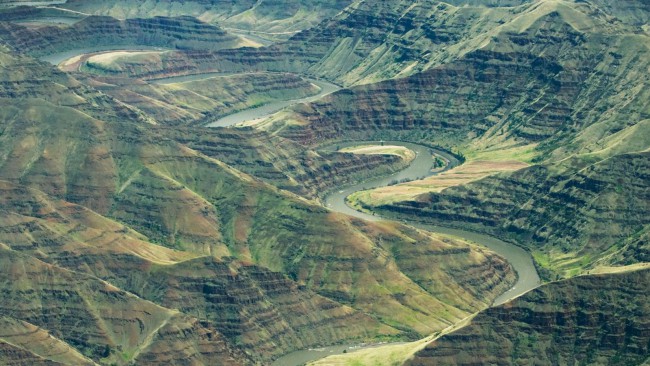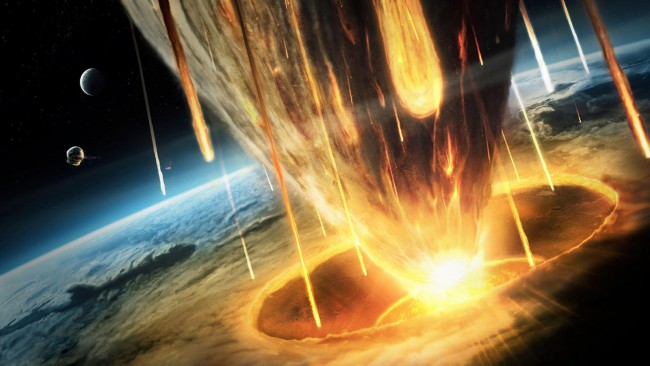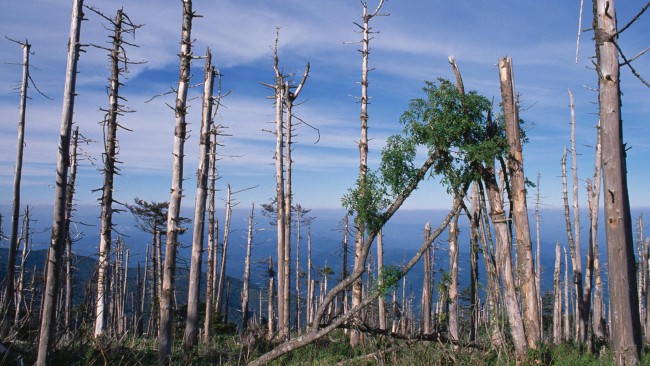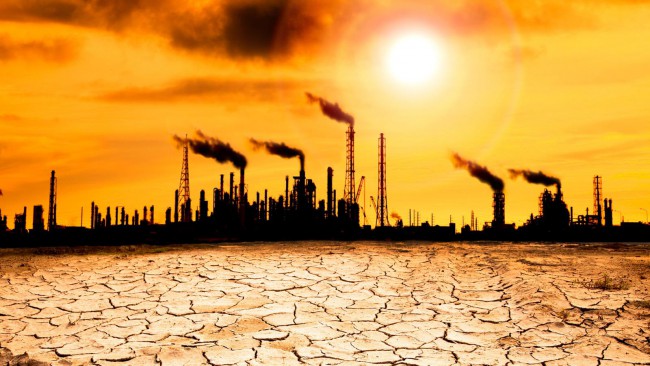
At some point in history, almost all species on land and in the sea disappeared. Now we know why. Mass Permian extinction, informally known as the Great extinction (The Great Dying), is one of the most large-scale geological phenomena in the history of life on Earth. In a relatively short period of time about 70% of vertebrates living on land, and about 90% of marine species disappeared from the face of the earth. The Permian mass extinction, if we say honestly, just became a major earth catastrophe. Earth for us is, first and foremost, and the life.
Ten years ago was not known for certain what the trigger is pulled from this most deadly catastrophe 252 million years ago. The reason was shrouded in mystery, scientists have proposed dozens of theories.
And just recently, the progress in the technology of Dating and finding geological evidence provided an accurate indication. Most earth scientists agree that the greatest of the extinctions the “big five” was caused millions of years of volcanic activity.
But whether that resolves the mystery? Not quite.

Yeah, about 5 million cubic kilometers of lava came out somewhere on the site of modern North-Western Siberia — enough to cover the soil surface to a depth of 10 meters — and it happened shortly before the mass extinction. This caused the release of huge amounts of greenhouse gases that supported global warming and seriously destroyed the life support system of the Earth.
However, precise details on how exactly this led to the extinction of such a large number of isreport, remain the subject of fierce scientific debate.
And it’s not just academic interest. This catastrophic event has played an important role in shaping the flora and fauna that we see today. In addition, there are clear Parallels between environmental changes that occur then are observed today. Some say that raising awareness of our species about the times when life almost ceased to exist, will help us to ensure its own survival in the long run.
In 1980 Luis and Walter Alvarez, the father and the son from the University of California at Berkeley, has provided a new and convincing proof that the most famous of the mass extinctions that happened to the dinosaurs 66 million years ago — was the result of a fall of a massive asteroid. And sparked interest in the causes of other mass extinctions, including the largest end of the Permian.

Then the Western “hunters extinctions” was less evidence that can be accessed, because they were located in China and Russia, not the most open countries. But this did not prevent them to offer a different theory.
Some reported side effects of the formation of the supercontinent Pangaea, like lowering the depth of the marine habitat, home to most marine species. Others noted a sharp drop of oxygen in samples of rocks of the end prize and fall of sea levels — both of these reasons could explain why marine species had so lousy.
Others suggested a massive release of methane from the seabed. There was still the possibility that intense volcanism, which has left so much volcanic rock in Siberia, was a special factor. Each subsequent lava flow spread over the previous, creating a series of stepped hills. They are called the Siberian Trapp — from the Swedish “Trapp”, i.e. the steps.
“Then it was thought that the mass extinction of the end of the prize lasted for several million years,” says Paul Vignal, a geologist from the University of Leeds, who published a book on mass extinctions ‘The Worst of Times’ in September 2015.
After collecting samples in the Dolomites, Italy, Vignal and Anthony Hallam of the University of Birmingham concluded in an article published in 1992 that the extinction actually lasted tens or thousands of years.
These short time frame has led many to go in search of a short but sharp catastrophe that could explain the extinction — for example, of the falling asteroid.
In favor of this idea some scientists point to rare grains of quartz shock in Australia — the grains were at the place of the alleged impact and have been subjected to strong physical effects in the process. Other scientists working in Antarctica, discovered helium and argon with isotope ratios similar to those possessed of carbon-rich meteorites in the early solar system.
But no impact crater was found, and it decayed.
“We have no geological evidence of a stroke or any other major event that could lead to the extinction of such magnitude, except for the Siberian Trapp,” says Jonathan Payne, a geologist, an expert on mass extinctions from Stanford University in California, USA.

As improved methods of Dating and samples were gathered, volcanism has gradually become the main culprit — in particular, after scientists concluded that the Siberian traps were formed about a million years ago, not 10-50 million years, as previously thought.
Effects the Siberian Trapp were horrifying. The biggest effects are observed in the oceans, in particular on the seabed.
Many groups have completely disappeared, including one of the earliest groups of arthropods — trilobites and primitive rugose, corals, blastoid, relatives of modern sea urchins and starfish. Others, like brachiopods, bryozoans, camaroptera Ammonites and crinoids, has lost most of its species.
Floating a bit luckier: fish acanthodian and placoderms are extinct, but many other fish and preobrazaj conodonts remained virtually untouched.
Terrestrial organisms were also affected. A lot of major groups were destroyed, including gorgonopsid, saber-toothed dominant predators of the time and bulky herbivores of pareiasaurus.
According to Dmitry Shcherbakov from the Paleontological Institute in Moscow, approximately 40% of families of insects the end, the prize was destroyed. Many Equatorial groups, like cockroaches and cicadas, moved North with the growth temperature.
As for plants, forest species were virtually eliminated.

Many groups of gymnosperms are dominant have declined. Coal produced about 10 million years, which indicates the disappearance of peat-producing plants. Another sign of definite fatal destruction of plants is “mushroom jump” — a huge increase in the number of fossilized fungal spores.
“It is interpreted as the result of an explosion of fungi living on dead or dying trees, said Barry Lomax from the University of Nottingham in the UK. — We have not seen on any other geological boundary”.
An accurate analysis of what died and when he died, thus, offers some of the best tips that will explain how the Siberian traps could have such a big impact.
When Vignal and colleagues from the Chinese University of earth Sciences in Wuhan have studied in detail the samples that showed the fate of 537 marine species in China, they found that 92 percent of them were destroyed. They also found that extinction took place in two phases separated by 180 000 years.
The first one was particularly deadly for shallow-water inhabitants like corals living at the bottom of fusulinid microscopic animals and plankton Radiolaria. Extinction of the second wave occurred in the depths of the ocean.
New species develop quickly after the first wave, but the recovery was much slower after the second — apparently, because of the long-term causes, which have undermined the basis of many deep ecosystems. Other evidence obtained with plant remains, recovered in Greenland and Antarctica support the idea of dual mass extinction.
What was in the Siberian volcanism, which caused so much destruction to life in its different manifestations Perm?
Together with the lava came out huge volumes of greenhouse and other harmful gases. They included huge quantities of carbon dioxide and sulphur dioxide, which has led to the growth temperature.

Heating of the oceans has reduced their ability to hold oxygen, and the streams that used to bring oxygen into the depths, could slow down or stop. The lack of oxygen, according to, was the main cause of the marine extinction is shown by the rock samples at the boundary between two geological periods in different places around the world.
“Almost all sedimentary rocks that we saw, passed from the oxygen-rich and life-poor to oxygen and life, says Mike Benton, a palaeontologist from Bristol University. — This line is absolute, like the blade of a knife, and clearly visible”.
Some argue that increasing the level of carbon dioxide in the atmosphere, its level was increased in the oceans, the water becomes more acidic and less contributed to marine organisms to make their shells. Elevated levels of carbon dioxide did poorly on a system of exchange of oxygen of marine animals.
“People talk about the deadly Trinity: warming, acidification and desoxyanisoin, says Payne, who argues that acidification could last tens of thousands of years. — All these things affect the lives of marine animals, their metabolism and oxygen use”.
Vignal, however, downplays the role of ocean acidification. “Without a doubt, if you will podkislit the surface of the ocean, will be affected, but most of the organisms will still be able to make their shells, because doing it in their bodies, without contact with the surrounding sea water”.
Warming has had significant implications for the sushi but not comparable to those which led to the extinctions of such magnitude at that time. Geologists blame the release of harmful CFC-like gases like chloromethane.
These gases are believed to appear when the layers of charcoal and salt are heated as you move the magma up to the surface of Siberian. They lead to the destruction of the ozone layer, which leads to a substantial increase in exposure to harmful ultraviolet radiation from the sun.
The arguments in support of this theory appeared in 2004, when Henk Visscher of Utrecht University in the Netherlands provided evidence of a substantial increase in the fossilized spores mutated lycopsids during the mass extinction of the end prize.
Others suggested that environmental stressors like increased aridity, rather than an increase in radiation could cause mutations. Lomax, however, supports the theory Vishera. “There have been other periods of prolonged aridity, and we see no evidence of their connection with the mutation spores, so it seems more logical to explain them by UV radiation”.

The gases emerging from volcanoes, formed a carbolic, sulphuric and other acids, awarded in the form of acid rain, which exacerbated environmental hazards. It demonstrates how the environment could destroy species directly and indirectly overnight.
“The loss of plants from UV radiation and acid rain were to remove the base of the food chain on land, leading to starvation of herbivores, which, in turn, were a source of food for carnivores,” says Benton.
Many believe that such ecosystem linkages need to think and people of the 21st century, as our activity increases the concentration of carbon dioxide in the atmosphere to an extreme level. The extinction of the late Permian period gives food for thought.
“In essence, we are creating or accelerating mass extinction of the end of the prize, says Vinal. — But it will take much time to heat the oceans, and models indicate that the oceans will be in trouble in 200-300 years from the point of view of the dissolved oxygen content, and ocean circulation will appear in a couple thousand years. Who knows what we’ll then do”.

Payne indicates that the mass extinction of the late Permian period can be seen as favorable for life in the long term — the total number of species on Earth eventually grew even more than it was — but his time frame is not given food for comfort.
“The biggest extinction in the history of life, has much in common with the environmental changes occurring today and which we can expect in the next 100-1000 years, he says. — In fact, in the long run, this will have a stimulating impact on the diversity of ecosystems, but restoration will take millions of years, so the loss of diversity is difficult to name useful to human society”.
In his book ‘The Great Paleozoic Crisis’ 1993 American paleobiology Doug Ervin likened the task of assessing potential causes of mass extinction the end of the prize with the situation in which Hercule Poirot in “Murder on the Orient Express”. Agatha Christie detective eventually comes to the conclusion that the murder involved all the passengers on the train.
In his recent book Vignal describes the output Poirot, saying, “everyone was doing it” as “lazy”. Instead, he cites the example of Sarah Lund, star of Danish crime drama “Murder.” The list of suspects grows with each series. (It would be more convenient to cite the example of Chekhov’s “the Seagull”). I Wingala killer — volcanism resulting consequences in the form of warming, deoxygenation ocean and the destruction of the ozone layer.
However, scientists gain access to greater volume of more accurate data, trying to highlight the differences in the precise combinations of causal factors of extinction in different ecosystems, groups and species that may not provide direct answers. If it’s a criminal and one piece, it is very difficult, with a bunch of corpses, and killed a variety of weapons.
“Environmental causes are multiplied rather than fold, so it’s hard to pick one thing,” says Payne. It is not a failure of science, but rather an indictment of our requirements are simple answers.
